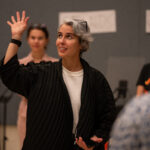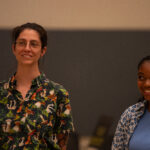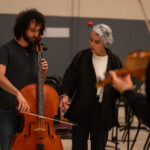Artist-in-Residence (2025)
Clarice Assad is currently serving as the Arts for All Artist in Residence at the University of Maryland’s School of Music (Terps Music). She is engaged in interactive musical sessions and is involved with various performances and educational activities at the university. Notably, she participated in a special UMD Wind Orchestra performance featuring her compositions. Her residency includes collaborations focused on sustainable storytelling through music, such as an event called “Voxtopia” related to climate change, which offers an interactive and immersive musical experience.

Highlights
Position: Arts for All Artist in Residence at University of Maryland, School of Music
Activities: Performances with UMD Wind Orchestra, interactive sessions, music education, sustainable storytelling projects
Special events: Participated in a climate-change related music event “Voxtopia”
Residency context: Collaboration with Arts for All, Office of Sustainability, and School of Music at UMD
Duration and full schedule details can be found at the UMD website and include ongoing engagement through the end of December 2025
Other Collaborations with the University of Maryland:
“A World of Change” (2022)
Assad premiered her original piece “World of Change” on April 10, 2022, at The Clarice Smith Performing Arts Center, accompanied by pianist Lara Downes and percussionist Britton-René Collins Award winning composer Clarice Assad premieres original piece ‘World of Change’. The concert was originally scheduled for 2020 to focus on climate change effects, but was rescheduled due to the pandemic and evolved to reflect the post-pandemic world Award winning composer Clarice Assad premieres original piece ‘World of Change’. The piece aimed to bring awareness about how humans jeopardize our ability to live on Earth.
Continued Involvement (2024)
In February 2024, Assad appeared as vocalist and guest composer with the UMD Wind Orchestra, performing works she had written, including a piece arranged by Michael Votta, Jr., and performing in a work highlighting the plight of the Amazon region in Brazil.(Amazônia Sem Lei)
Explore the Class:
Environmental Storytelling through Music & Technology
Powered By EmbedPress
MULTIVERSE: Another Rite of Spring (2023)
MULTIVERSE: Another Rite of Spring was commissioned by the University of Maryland Wind Orchestra. This programmatic work reimagines Igor Stravinsky’s The Rite of Spring from the perspective of the sacrificial maiden, exploring parallel realities and questioning whether her journey must lead to death Clarice Assad | Multiverse.
The piece had a preview performance on February 10, 2023, before the UMD Wind Orchestra traveled to the University of Georgia to perform at the College Band Directors National Association (CBDNA) National Conference CBDNA National Conference Preview Concert: UMD Wind Orchestra • IN-PERSON | The Clarice Smith Performing Arts Center. The work was originally premiered by the UMD Wind Orchestra in Spring 2023
University of Maryland Wind Orchestra (UMWO) Commission
MULTIVERSE
Program Notes By Clarice Assad
In 2019, I received an email from conductor Michael Votta with an intriguing vision for a commission: How would you like to write a response to Igor Stravinsky’s “The Rite of Spring,” experienced through the eyes of the sacrificial maiden? I wrote back immediately, saying, “I want to hear more.”
He told me the subject came up during a conversation with a woman who mentioned her scariest moment in music is in the Rite of Spring when the young woman dances herself to death. It was easy to agree with her on this. How awful it must have been for this young woman to be put to death at such a tender age to please the Gods of Spring that may not exist. The music sounds terrifying, and the choreographies I have seen over the years are up to par. But what about this girl? Was she accepting of her fate or felt forced into it? So many questions popped up; most importantly, who was this person? How was her life before? Her dreams? I wanted to explore.
There were many angles to tackle this story, but a light bulb moment occurred when I envisioned this poor young lady living as multiple versions of herself at different places and times. That is how MULTIVERSE came into being. In this re-telling of the Rite of Spring, the experience is multi-fold. Here, the story begins in tandem with the first part of the actual Rite of Spring, and each movement bears the exact title as in the original. But in Multiverse, the story ends right before the Sacrifice. We only go as far as when the victim discovers she is the chosen one. We are not sure whether she will die or escape. As in the original, we begin with the introduction, “Adoration of the Earth,” and hear the most famous melodic fragments of the original piece, often in distorted ways. The glitchy nature of this passage suggests that we are experiencing many realities at once but, eventually, focus on the new one.
The second movement, “Dances of the Young Girls,” offers an unfamiliar sound world contrasting with the Rite’s most famous pulsating and visceral passage. It is cheery and full of playfulness. The young girls in this dimension are dancing to another tune, literally. They might not know what is coming their way. Everything seems like a game. Their naiveness is almost heart-wrenching as the dance segues into Movement III: Mock Abduction, and quotes from the Rite of Spring are peppered through this section, first with the jest from the girl’s nature, but that eventually becomes ominous and serious, a suspicion of bad things to come. Still, there is a sense of hope in this alternate macrocosm, where events are happening through their young and innocent eyes.
In Movement four: Spring Rounds, we experience a ritual musically influenced sounds of ancient Mesoamerican sounds, and in movement V, “Games of the Rival Tribes,” the backdrop changes once again into another set of musical quotes from different parts of the original score, influenced by jazz.
In the final Movement “Dance of The Earth,” the main character shifts between realities as if trying to escape her ultimate destiny: Death.
"There is music wherever there is rhythm, as there is life wherever there beats a pulse."
Igor Stravinsky
Composer


I. Introduction
As in the original, we begin with the introduction, "Adoration of the Earth," and hear the most famous melodic fragments of the original piece, often in distorted ways. The glitchy nature of this passage suggests that we are experiencing many realities at once but, eventually, focus on the new one.

II. Dance of the Young Girls
The second movement, "Dances of the Young Girls," offers an unfamiliar sound world contrasting with the Rite's most famous pulsating and visceral passage. It is cheery and full of playfulness. The young girls in this dimension are dancing to another tune, literally. They might not know what is coming their way. Everything seems like a game. Their naiveness is almost heart-wrenching

III. Mock Abduction
In Mock Abduction, quotes from the Rite of Spring are peppered through this section, first with the jest from the girl's nature, but that eventually becomes ominous and serious, a suspicion of bad things to come. Still, there is a sense of hope in this alternate macrocosm, where events are happening through their young and innocent eyes.

IV. Spring Rounds
In Movement four: Spring Rounds, we experience a ritual musically influenced by hints of ancient Mesoamerican sounds,

V. Game of the Rival Tribes
In Movement V, "Games of the Rival Tribes," the backdrop changes once again into another set of musical quotes from different parts of the original score, influenced by jazz.

VI. Dance of The Earth
In the final Movement "Dance of The Earth," the main character shifts between realities as if trying to escape her ultimate destiny: Death.








